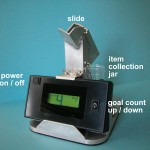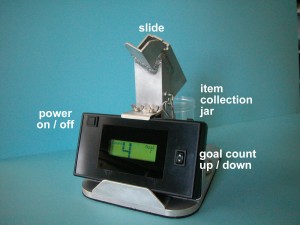Designers: John Dumas and Blair Roszell
Client Coordinator: Judy Stroupe, Orange Enterprises, Inc.
INTRODUCTION
Orange Enterprises, a Hillsborough NC based company, employs people with cognitive and/or physical disabilities to perform tasks, including packaging of the PEP-R Autism Test Kit. This kit includes several jars filled with small items, such as blocks and dowels. In order to assist employees in packaging the kit, we designed a device to help the workers count and package these items. The device can be set to count a specific number of items and to indicate when the proper number of items has been counted.
To use this device, a supervisor sets the “goal count” to indicate the number of items, i.e. blocks or dowels, that should be packaged in the jar. Then the employee drops the items, one at a time, onto a slide. The item proceeds down the slide and passes over a transducer that detects its presence and increments the count; it then falls into the jar for packaging. The supervisor can place different templates over the opening of the slide to restrict which items can be inserted there.
SUMMARY OF IMPACT
This device will assist employees of Orange Enterprises who have disabilities such as Autism or Cerebral Palsy to more accurately and efficiently package small items. Because employees of Orange Enterprises are paid on a per-unit basis, increasing the speed and accuracy with which they perform their job will translate into increased pay. According to Judy Stroupe, client coordinator, “The small item counter will allow people with severe and multiple disabilities to assist with the configuration of the PEP Kits, increasing their independence and also [increasing] their pay.”
TECHNICAL DESCRIPTION
The primary component of the device is a PIC microcontroller (Microchip, Chandler AZ), which is connected to the input switches, the LCD screen, and an optical sensor that detects the passing of small objects down a slide.
In order to be counted by the optical sensor, each object must pass within close proximity to the sensor at a sufficiently slow rate to allow detection. Furthermore, the objects must follow a well-defined path, and be in such an orientation that they are recognizable by the sensor as they pass over it. An aluminum slide was created to accomplish these tasks. The proper orientation of each object is established by one of four different templates that are placed over the opening (see figure 2), corresponding to the four different objects that are counted for the PEP kits. Because the slide is rectangular rather than cylindrical, the objects lie flush against the inner surface of the slide, thus maintaining the proper orientation. The angle of the slide also helps to maintain the proper orientation, such that they cannot rotate freely during their progression down the slide. The resulting design ensures that the objects will be reliably detected by the sensor.
The optical sensor is a reflective photointerrupter, which is sensitive enough to detect small and large, as well as translucent and opaque objects. Switches for Reset, Power, Up, and Down connect directly to the PIC.
One of the limiting factors of the PIC microcontroller is having it run fast enough to detect slight changes in signals from the photointerrupter. To enhance the program’s execution speed, the buttons are attached to interrupts that intervene in the program only when pushed. Additionally, in its current configuration, the LCD is updated only when the count or goal count is changed. The PIC is programmed in C.
The display and the buzzer are the two ways that the device indicates the goal has been reached. Since the device has no auxiliary lights to alert the user, the incorporated LCD screen is capable of writing in large, bold letters to enhance visibility. When the goal count is reached, the display reads “DONE” in letters that consume the entire screen. This message is accompanied by a subtle beep. One of the requirements for the device is that it will be used in a work setting, so it should not disturb or distract other workers. The display and the buzzer convey a clear message that the user is done in an appropriate manner for the working environment.
The total cost of the device is $381.94




University Operator: (919) 962-2211 | © 2024 The University of North Carolina at Chapel Hill |